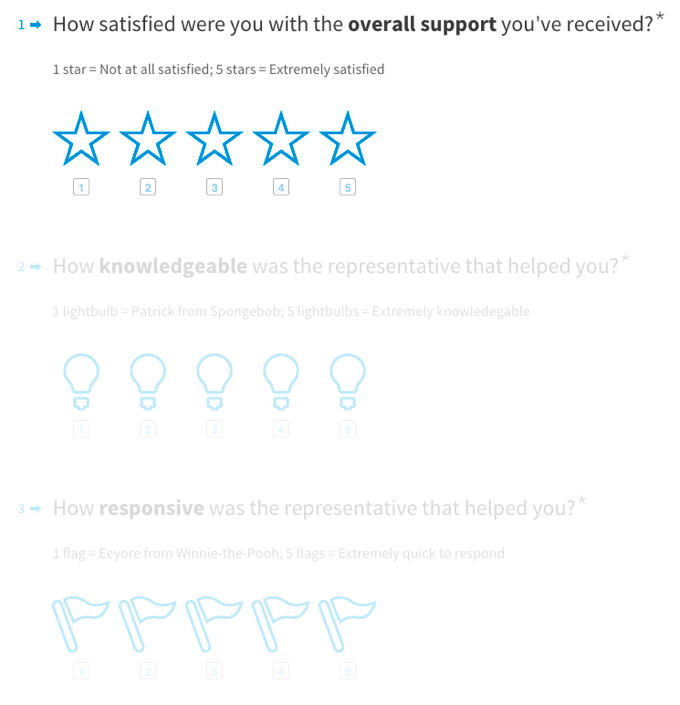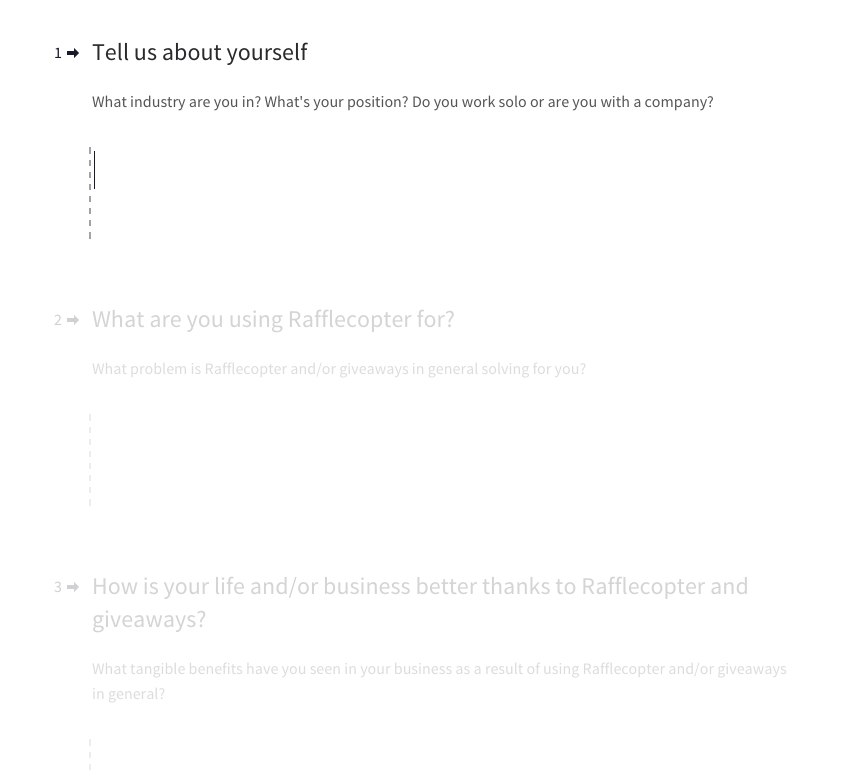
Not long ago I received my first four star chat rating in customer support. You see, that’s four out five available stars, which is eighty percent satisfaction, which is basically a ‘meh’ in Rafflecopter’s customer support world.
As I watched my perfect score slip between my fingers, I started rehashing the conversation. Where did I go wrong? Did I not use enough smiley faces? Could I have been a little more clear in my response? Did they have a high school nemesis named Brittany? I still don’t know the answer, but I do know that those four stars loomed over my head for the next week. Let’s face it, I’m writing about it a month later, so maybe I’m still not over it. All I ever wanted was to be perfect.
We take customer feedback very seriously at Rafflecopter. It’s on the forefront of our minds, and we talk about the ‘pulse’ of our customers on a daily basis. Our customers are the first to tell us when we’re being awesome, and the first to tell us when we’re being dumb. We listen to our customers, and it keeps us in check. Here is a look at our feedback process and why we think it’s essential to our growth.
Collecting Feedback
Aside from the aforementioned chat rating, we collect feedback through multiple channels depending on the area of focus: tickets, emails, in-app messages, etc. Sometimes we do surveys, and sometimes we do personal messages. I’ll clue you in on our bag of tricks.
Customer Support
We use surveys to insure we’re providing the best customer support possible. These scores are a reflection of the quality of support we offer, and they keep us motivated to stay on top of it.
Here is an example of the Typeform survey our customers receive as a link in our signature at the bottom of a support ticket:

We want our service to be fast, effective, and friendly, so that’s what we ask about. We only ask essential questions to keep the survey as short as possible. Surveys shouldn’t take any longer than a few minutes to complete, and if they do, you should offer your customers a freebie (discount code, free download, etc). Bribery is where it’s at.
While open-ended questions will provide you with the most helpful answers, they require a bit more effort on behalf of the participant so the completion rate isn’t quite as high. This is why we provide a quick 5 star rating with the option to elaborate at the bottom. About half of our surveys are star reviews without any comments, which is still helpful in monitoring the general effectiveness of our support.
Product
Every single person on the team is thinking about how to improve Rafflecopter, and we often look to our customers for product feedback. Here are a few ways we collect commentary regarding product improvements.
Zendesk: This is where we receive the most feedback about our product and where we can get a good understanding of what’s working for our customers and what’s not. We use Zendesk to manage customer support which allows us to use snazzy macros. We create macros whenever we find ourselves typing out the same answer over and over.
At the end of the month, we rank the macros and focus on the most used. This helps us identify weak points in the product and where to focus our attention on the next version of Rafflecopter. If we’re constantly having to macro “how to update your credit card” then we should probably revise the process on our dashboard.
Personal emails: Speaking directly with customers about our product is hands down the most useful tool for feedback. We conduct monthly case studies where we talk to customers who have had success with our product. They’ve already done a great job marketing the promotion, so the conversation is really about our service. This is when they can tell us what they loved, and what they wish we offered. They know exactly what they’re willing to pay for. They are quality customers with great insight, and we love the opportunity to speak with them one on one.
Intercom: This tool allows us to send out semi-personalized messages that correspond with specific events within an account. For example, we have a survey that goes out to users who have created a paid account within the last 24 hours. Our goal is to find out why they signed up and what they considered when making the decision.

Other questions included:
- Did you consider any alternatives to Rafflecopter?
- What made you sign up for Rafflecopter?
- Which doubts and hesitations did you have before signing up?
- Which questions did you have, but couldn’t find the answers to?
- Anything else you would like to tell us?
The answers to these questions are helpful when making product and marketing decisions. This is how we find out what to say and when to say it!
Sifting Through Feedback
Collecting feedback is half the battle. Deciding what to implement is where it gets tricky. As any researcher knows, people don’t always behave the way they say they will behave.
You wouldn’t propose to someone just because they said they’d date you. So don’t build features just because people said they’d use them.
— Intercom (@intercom) January 18, 2013
While we don’t want to disappoint customers, we have to decide what makes sense for the product and our customers at large. As a small team, we have to be selective when implementing product features. We don’t want to spend a ton of developer time on something that won’t add much value or only a fraction of our customers will use it.
We keep a running list of product feedback on GitHub and everybody on the team has a chance to make their case about why the change should be implemented or why it shouldn’t be implemented. It’s hard not to get lost in the weeds while trying to be a people pleaser, so having multiple people weigh in on the discussion is helpful.
If customers are begging you to take their money for a certain feature, you should probably consider it. But you can’t lose sight of your brand and your vision for the product.
Executing on Feedback
You gotta keep your priorities straight! Maintaining functionality and security of the current site is always going to take precedence over adding new features. You can’t put icing on a cow patty and call it a cake! The foundation has to be right, so our team prioritizes tasks.
Divide and Conquer
While the technical team focuses on building new features and maintaining a stellar product, the business team focuses on brand messaging and product offers. If people still don’t understand our pricing model or how to install the widget, there’s work to be done! We strive to be the most user-friendly tool on the internet.
The Follow-up
When a top feature is requested, we add a tag to the customer’s account in Intercom. When the feature is implemented, the customer is notified. If a customer goes out of their way to complete a survey or submit a support ticket about how to make your product better, the least you can do is notify them of the upgrade! It’s great for retention and overall customer satisfaction.
Conclusion
We’ve found that it pays to listen. Much of our growth can be attributed to this principle, and we’ve spent quite a bit of time refining the process around integrating customer feedback into our product. Without our customers, there would be no Rafflecopter.
Have you found it difficult to balance customer feedback with maintaining your product vision? I’d love to hear how you do it!